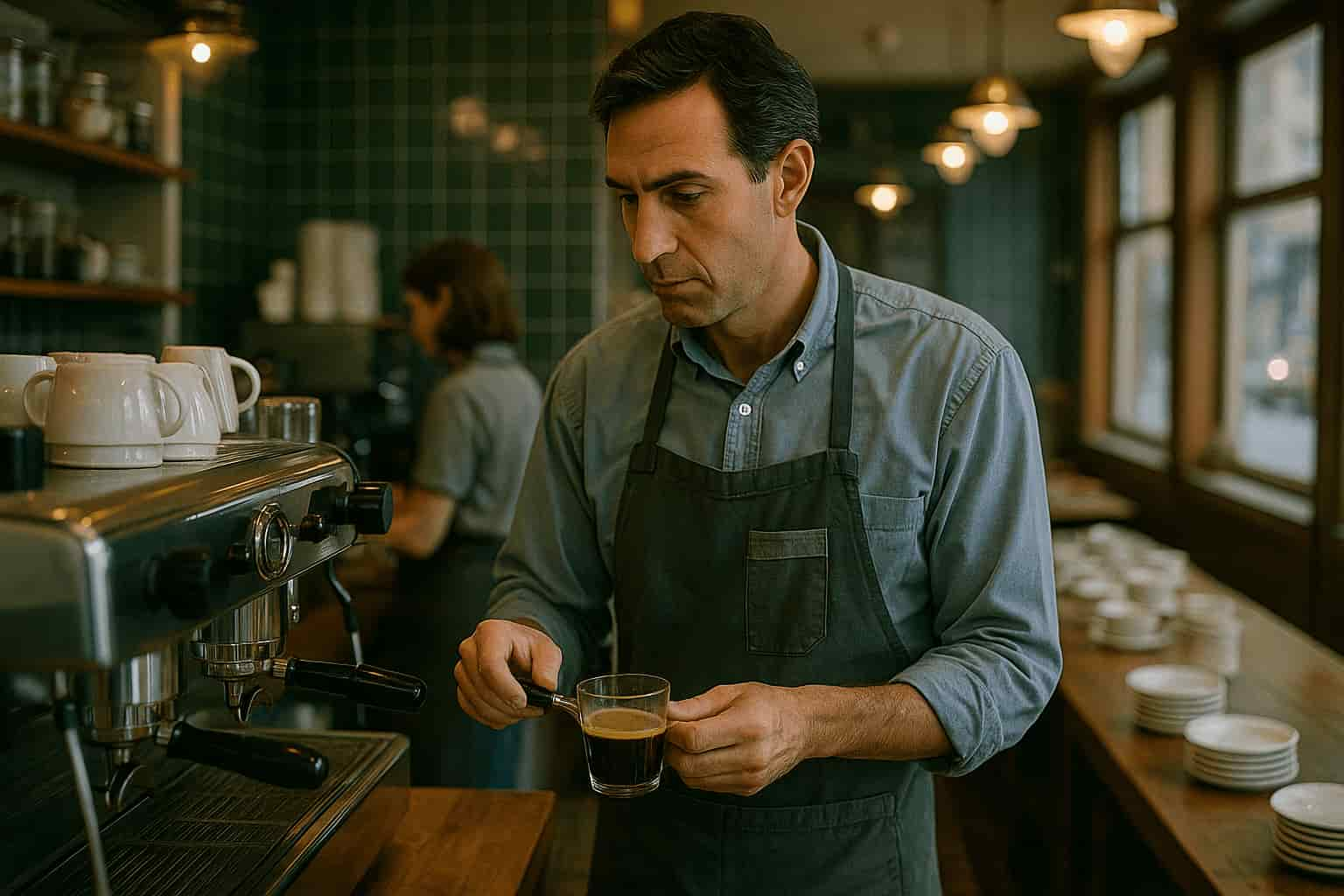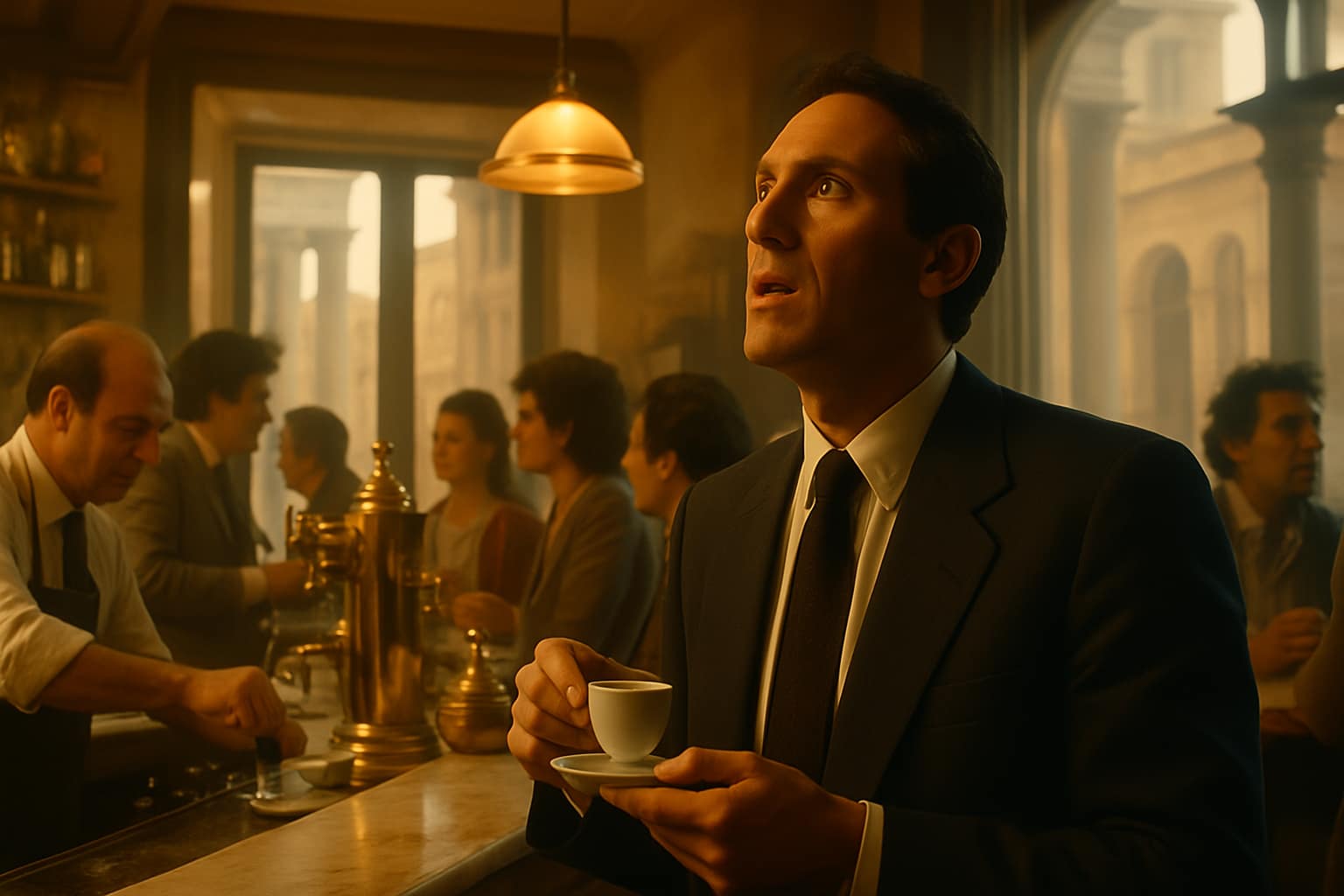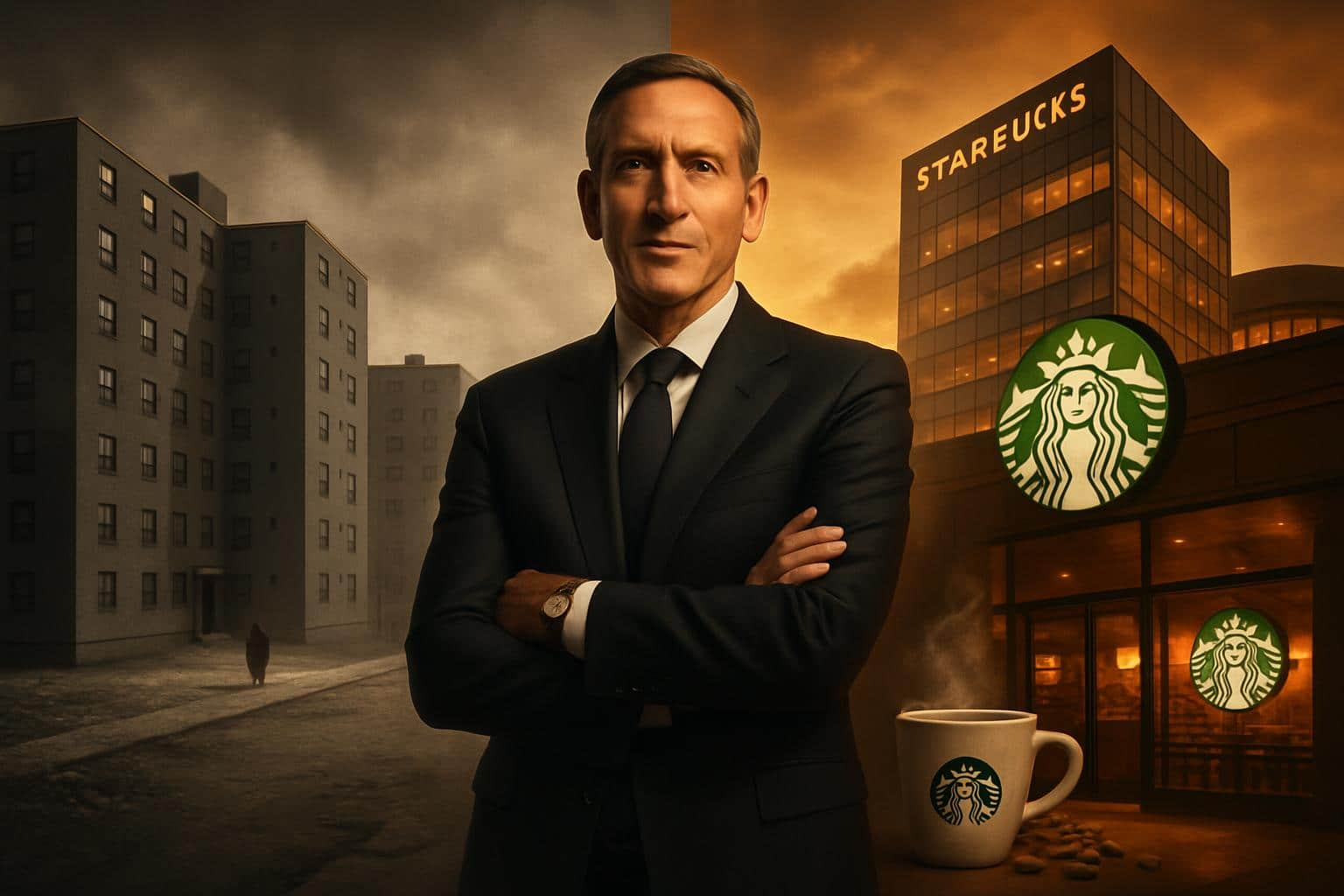Table of contents
- Early Life & Struggles
- Turning Points
- Breakthrough Success
- Key Business Moves
- Legacy & Lessons Learned
- Transforming Coffee Culture
- Industry Transformation
- Leadership Philosophy and Values
- Communication and Transparency
- Entrepreneurial Lessons
- Learning from Other Cultures
- Philanthropy and Social Impact
- Political and Social Engagement
- Enduring Impact
- Inspiration for Future Generations
- The American Dream Realized
- Sources:
Howard Schultz transformed from a poor kid in Brooklyn’s housing projects into the visionary leader who built Starbucks into the world’s largest coffeehouse chain. His journey represents one of America’s most compelling rags-to-riches stories. It shows relentless determination, innovative thinking, and unwavering commitment to treating people with dignity.
Born into poverty and raised in federally subsidized housing, Schultz faced challenges that would have crushed many spirits. Yet these early hardships became the foundation for his revolutionary approach to business. His story proves that extraordinary success can emerge from the most ordinary beginnings.
Early Life & Struggles
Growing Up in the Projects

Howard Schultz entered the world on July 19, 1953, in Brooklyn, New York. His parents were Fred and Elaine Schultz. His father worked as a truck driver while his mother served as a receptionist. Neither parent had finished high school. Both struggled to make ends meet in post-war America.
Until age three, young Howard lived with his grandmother in cramped quarters. In 1956, the family moved to the Bayview Houses. This was a federally subsidized housing project in Brooklyn’s Canarsie neighborhood. Their building housed approximately 150 families. All shared a single small elevator. The Schultz family occupied a cramped two-bedroom unit on the seventh floor.
“I did not have an unhappy childhood, but we lived daily with the constant stress of financial issues,” Schultz later recalled. The weight of poverty pressed down on the family like a heavy blanket. “There were times when I felt angry and ashamed of our situation.”
Community and Resilience
Despite the challenging living conditions, Schultz learned valuable lessons about resilience and community. He discovered how to get along with many different kinds of people. The projects provided plenty of playmates. This created a diverse social environment that would later influence his inclusive business philosophy.
The experience taught him that circumstances don’t define character. Hard work and determination could overcome even the most difficult situations. These lessons would prove invaluable in his future business career.
The Defining Moment

When Howard was seven years old, a traumatic event shaped his entire worldview and future business philosophy. His father suffered a serious injury on the job. He was dismissed without notice. The family suddenly found themselves without healthcare, income, or worker’s compensation.
This devastating blow left an indelible mark on young Schultz. His mother was seven months pregnant at the time. This made the situation even more desperate. The family lost not only Fred’s income but also any health care benefits for all family members.
“It was not the calling of coffee, but the calling to try to build a company that my father never got a chance to work for,” Schultz would later explain. This moment planted the seeds for his revolutionary approach to employee benefits and workplace dignity.
Father’s Struggles
Fred Schultz, a World War II veteran, had never taken advantage of the GI Bill. He remained what Schultz described as “a beaten man” and part of “the working poor.” Throughout his life, Fred worked various blue-collar jobs. These included cabbie, truck driver, and factory worker. Often, he worked two or three jobs simultaneously just to put food on the table.
The sight of his father’s struggles burned into young Howard’s memory. He vowed that someday he would create a company that treated workers with dignity and respect. This promise would guide his entire business philosophy.
Early Work and Determination
By age twelve, Howard began working to help support his family. He started with a paper route. Then he worked behind the counter at the local luncheonette. These early jobs taught him the value of hard work and customer service.
At sixteen, his after-school job took him to Manhattan’s garment district. There he worked at a furrier. Each day, Schultz took the subway to what he called a “horrendous job” stretching animal skins. He earned only five cents per skin. But every penny mattered to his struggling family.
Summer Jobs and Sacrifice
During one particularly difficult summer, he worked in a sweatshop steaming yarn at a knitting factory. The conditions were brutal, but Schultz persevered. He always gave part of his earnings to his mother. Not because she asked for it, but because he felt deeply for his parents’ situation.
Despite the financial pressures, Schultz’s mother, Elaine, remained a powerful force in his life. She possessed an unshakeable belief that her children deserved better. “Even though she and my father had not achieved the American dream, she felt her children were entitled to a piece of it,” Schultz remembered. Her biggest dream was a college education for all three of her children.
Turning Points
Athletic Success Opens Doors

Schultz’s biggest triumph in high school came when he became quarterback of the football team. In a school that included nearly 6,000 students, this achievement represented no small accomplishment. His athletic ability became his ticket to a better future.
A recruiter from Northern Michigan University offered him a scholarship to play football. Schultz quickly accepted the opportunity. “It felt as good as an invitation to the NFL draft,” he said. “I’m not sure I would have gone to college if I hadn’t received this opportunity.”
The scholarship represented more than just financial assistance. It symbolized hope and possibility for a young man who had seen little of either. For the first time, Schultz could envision a future beyond the projects.
Overcoming Setbacks
However, an injury ended his football dreams. This forced him to find new ways to pay for his education. He took out loans and worked part-time during the school year. He worked full-time during summers. Despite these challenges, he remained determined to complete his degree.
This setback taught Schultz an important lesson about resilience. When one door closes, successful people find another way forward. This mindset would serve him well in his business career.
College Years and First Taste of Success
At Northern Michigan University, Schultz majored in communications. He became a member of the Tau Kappa Epsilon fraternity. More importantly, he became the first person in his family to graduate from college. This achievement represented a monumental breakthrough for the Schultz family.
The college experience exposed Schultz to new ideas and possibilities. He learned about business, communication, and leadership. These lessons would prove invaluable in his future career. Though he didn’t yet know where that career would lead.
Early Corporate Experience
After graduation, Schultz returned to New York. He joined the sales division of Xerox Corporation. During his three years there, he learned essential skills in sales, marketing, and presentation. The corporate environment taught him about professionalism and business operations.
Xerox provided excellent training in sales techniques and customer relations. These skills would prove crucial when Schultz later built his own business empire. The experience also showed him how large corporations operated.
The Swedish Connection

By 1979, Schultz had become a successful salesman, but restlessness began to set in. He learned that a Swedish company, Perstorp, was planning to establish a U.S. division. This was for its Hammarplast housewares subsidiary. The opportunity seemed exciting to get in on the ground floor of a growing company.
Schultz was hired and sent to Sweden for three months of training. The international experience broadened his perspective. It taught him about different business cultures. Soon, he was promoted to vice president and general manager of Hammarplast. He took charge of all U.S. operations.
Executive Responsibility
This role gave Schultz his first taste of executive responsibility. He learned about managing operations, building teams, and developing business strategies. These skills would prove crucial when he later took on the challenge of building Starbucks.
The position also taught him about international business and cross-cultural communication. These experiences would help him when Starbucks expanded globally.
Discovery of Starbucks
In 1981, while working at Hammarplast, Schultz noticed something unusual. A company in Seattle called Starbucks Coffee, Tea, and Spice was placing unusually large orders. They wanted Hammarplast drip coffeemakers. The orders were outpacing those from major department stores. This puzzled Schultz.
Curious about this phenomenon, he decided to visit the company. He wanted to understand why it was performing so well. At the time, Starbucks was a ten-year-old retail shop with five stores. It had 85 employees, a roasting facility, and a wholesale operation. They sold coffee beans to local Seattle merchants.
Seattle Revelation
The visit to Seattle proved transformative. Schultz was immediately enamored with both the business and the city. The passion and knowledge of the Starbucks team impressed him deeply. He saw something special in their approach to coffee and customer service.
In 1983, Schultz joined Starbucks as head of retail sales and marketing. This decision would change not only his life but also the entire coffee industry. He was about to embark on the journey that would make him one of America’s most successful entrepreneurs.
Breakthrough Success
The Italian Revelation

In 1983, Schultz embarked on a buying trip to Italy. This trip would revolutionize his understanding of coffee culture. While visiting Milan, he observed something remarkable. Italians were passionate not just about their coffee, but about their coffee bars as social gathering places.
The Italian coffee bar experience captivated Schultz completely. He watched as customers engaged in animated conversations while enjoying expertly crafted espresso drinks. The coffee bars served as community centers. People connected and shared their daily experiences there.
Vision of the Third Place
At the time, Starbucks was selling coffee only by the pound as a retail product. But Schultz saw enormous potential for transforming the stores into coffee and espresso bars. He envisioned creating a “third place” between home and work. People could gather and connect there.
Returning to Seattle with newfound enthusiasm, Schultz worked to persuade the original Starbucks founders. Jerry Baldwin and Gordon Bowker needed convincing to embrace the coffee bar concept. He painted a vivid picture of what Starbucks could become with the addition of traditional espresso beverages.
Testing the Waters
In 1984, Schultz convinced the founders to try the coffee bar concept. They opened a test store in downtown Seattle. The café proved immensely successful. This validated his vision of combining high-quality coffee with a welcoming social environment.
Despite the pilot’s success, Baldwin and Bowker remained reluctant to expand the concept further. Concerns about the high cost of espresso machines were among their main objections. Another issue was the relative lack of expertise for maintenance and repair in America. Additionally, they pointed out that most Americans were unfamiliar with espresso drinks.
The Bold Decision
Frustrated by their hesitation, Schultz made a difficult decision. In 1985, he left Starbucks to pursue his vision independently. He was determined to prove that his concept could work on a larger scale.
This decision required enormous courage. Schultz was leaving a secure position to start his own business. He had no guarantee of success. But he believed so strongly in his vision that he was willing to risk everything.
Building Il Giornale

Schultz wrote a comprehensive business plan for his new company. He named it Il Giornale, Italian for “the newspaper.” The name reflected his vision of creating gathering places. People could share news and connect with their community there.
The fundraising process proved challenging and humbling. Schultz approached more than 240 potential investors. He presented his vision with passion and conviction. However, more than 200 of them rejected his idea. They viewed it as too risky or unfamiliar.
Persistence Pays Off
“You have to passionately believe in yourself and in your ideas,” Schultz later reflected. “Too many people with great ideas give up on them too early. You have to persevere and refuse to give up.”
Two of the original Starbucks founders invested in Il Giornale. This showed some faith in Schultz’s vision. Local doctor Ron Margolis provided another $100,000 investment. Eventually, Schultz raised more than $1 million to open his first coffee bar.
The First Il Giornale
By 1986, Schultz had raised the money needed to open the first Il Giornale store. The shop offered ice cream in addition to coffee. It had limited seating and played opera music in the background. While different from his ultimate vision, it represented an important first step.
Il Giornale proved successful enough to justify expansion. Schultz opened a second café in Seattle and a third in Vancouver, British Columbia. Each location refined the concept and built customer loyalty.
Validation of the Concept
The success of Il Giornale validated Schultz’s belief in the coffee bar concept. Customers embraced the combination of high-quality coffee and welcoming atmosphere. The stores became gathering places where people could relax, work, and connect with others.
This success set the stage for the next phase of Schultz’s journey. He was about to acquire the company that had first inspired him.
Acquiring Starbucks

In 1987, a remarkable opportunity presented itself. The original Starbucks management team decided to focus on Peet’s Coffee & Tea. They offered to sell the Starbucks retail unit to Schultz and Il Giornale for $3.8 million.
This acquisition represented a pivotal moment in Schultz’s career. He could finally implement his vision under the established Starbucks brand. The brand already had recognition and customer loyalty in Seattle.
The New Starbucks
Schultz immediately rebranded Il Giornale with the Starbucks name. He began expanding its reach across the United States. He maintained the company’s commitment to high-quality coffee while adding the social atmosphere he had envisioned.
The newly combined company established a clear mission. They wanted to create a company that treated people with dignity and respect. They would serve exceptional coffee in welcoming environments. This mission would guide every major decision as Starbucks grew from a small Seattle operation into a global phenomenon.
Key Business Moves
Revolutionary Employee Benefits
One of Schultz’s most significant innovations came in how he treated employees. Drawing from his childhood experience of watching his father struggle without benefits, Schultz made a revolutionary decision. Starbucks became the first U.S. company to offer comprehensive health insurance and stock options to all employees. This included part-time workers.
This decision was revolutionary in the retail industry. Part-time workers typically received minimal benefits. Schultz believed that treating employees well would create better customer experiences and stronger business results.
The Partner Philosophy
“If there is one accomplishment I am proudest of at Starbucks,” Schultz said, “it’s the relationship of trust and confidence we’ve built with the people who work at the company.” This philosophy became known as treating employees as “partners” rather than just workers.
The stock option program, called Bean Stock, gave every employee ownership in the company’s success. This approach created a culture of shared responsibility. It created mutual investment in Starbucks’ growth and profitability.
Going Public and Rapid Expansion
On June 26, 1992, Starbucks held its initial public offering (IPO). The company began trading under the stock ticker SBUX. The IPO raised $271 million for the company. This provided capital to fuel aggressive expansion plans.
Schultz used the IPO proceeds to double the number of Starbucks stores. This happened in a series of highly publicized moves that became known as the “coffee wars.” The company’s growth strategy focused on establishing a dominant presence in key markets. They wanted to do this before competitors could gain footing.
Franchise-Free Strategy
Unlike many retail chains, Schultz refused to franchise Starbucks locations. He insisted on maintaining ownership of every domestic outlet. This ensured consistent quality and customer experience. This decision required more capital but gave Starbucks greater control over its brand.
The rapid expansion strategy proved highly successful. Starbucks became synonymous with premium coffee. It created a new category of retail experience. The company’s growth attracted significant media attention. It established Schultz as a visionary business leader.
The 2008 Crisis and Dramatic Return

In 2000, Schultz stepped down as CEO to become chief global strategist. Orin Smith succeeded him. However, during his eight-year absence, the company grew from approximately 5,000 stores to 15,000. But the rapid expansion came at a cost.
By 2007, Starbucks was struggling. The stock dropped 42 percent. The company had lost its focus on the customer experience. Schultz wrote a memo to then-CEO Jim Donald about the company’s slow decline. This memo was later leaked to the media.
The Unraveling
“The damage was slow and quiet, incremental, like a single loose thread that unravels a sweater inch by inch,” Schultz later wrote in his book “Onward.” The pursuit of profit had become the primary focus. This overshadowed the company’s original mission.
On January 7, 2008, during the height of the financial crisis, Schultz returned as CEO. The board had ousted Donald. On his second day back, the stock jumped 8 percent. This signaled investor confidence in his leadership.
Dramatic Turnaround Strategies
Schultz implemented bold and sometimes controversial strategies to restore Starbucks’ focus and performance. In February 2008, he made an unprecedented decision. He closed 7,100 U.S. stores for three and a half hours. The purpose was to retrain baristas on making the perfect espresso.
The store closures cost Starbucks $6 million in lost revenue. But they sent a powerful message about the company’s commitment to quality. Major news outlets covered the event. This generated significant publicity for Starbucks’ renewed focus on coffee excellence.
Direct Communication
Schultz also invited customers to email him directly. He received over 5,000 messages. He made personal phone calls to stores across the nation. This was to assess conditions and gather feedback. This hands-on approach demonstrated his commitment to understanding and addressing problems.
The company invested in its first major national advertising campaign. They employed a new chief technology officer from Amazon. They introduced Pike Place roast to showcase their coffee expertise. Schultz also removed heated breakfast sandwiches from the menu. Their aroma overpowered the smell of coffee.
Technology and Innovation
Under Schultz’s leadership, Starbucks embraced technology to enhance customer experience and operational efficiency. The company updated its website and improved its social media presence. They replaced outdated cash registers and computers throughout their stores.
Starbucks introduced a national loyalty program that rewarded frequent customers. It provided valuable data about purchasing patterns. This program helped build customer retention. It enabled more targeted marketing efforts.
Global Expansion
The company also enforced fair trade standards. They made multiple acquisitions of American and Chinese beverage companies. Schultz’s aggressive expansion in Chinese markets helped reconcile the country’s traditional tea culture with growing coffee consumption.
These technological and strategic innovations positioned Starbucks for continued growth. They helped differentiate it from competitors. The company’s willingness to invest in new capabilities demonstrated Schultz’s commitment to long-term success rather than short-term profits.
Legacy & Lessons Learned
Transforming Coffee Culture

Howard Schultz’s impact extends far beyond building a successful company. He fundamentally transformed coffee culture in America and around the world. Before Starbucks, coffee was primarily viewed as a commodity product. People consumed it at home or in basic diners.
Schultz introduced the concept of coffee as a premium experience. It was worthy of careful preparation and enjoyable consumption. He positioned Starbucks as a “third place” between home and work. People could gather, relax, and connect with others there.
Industry Transformation
This transformation created an entirely new category of retail experience. It influenced countless other businesses. The Starbucks model inspired the growth of specialty coffee shops. It influenced artisanal food retailers and experience-focused businesses across many industries.
Schultz’s vision of coffee culture emphasized quality, community, and social responsibility. These values became integral to the Starbucks brand. They influenced how consumers think about the products they purchase and the companies they support.
Leadership Philosophy and Values
Throughout his career, Schultz demonstrated a leadership philosophy centered on treating people with dignity and respect. This approach stemmed directly from his childhood experiences. He watched his father struggle in jobs that offered no security or benefits.
“When you’re surrounded by people who share a passionate commitment around a common purpose, anything is possible,” Schultz often said. He believed that creating a positive workplace culture was essential for achieving business success.
Communication and Transparency
Schultz’s leadership style emphasized transparency, communication, and shared ownership of success. He regularly communicated with employees through company meetings, emails, and store visits. This approach created a sense of connection between leadership and front-line workers.
His commitment to social responsibility extended beyond employee benefits. It included community involvement, environmental sustainability, and ethical sourcing practices. Starbucks became known for taking stands on social issues and supporting various charitable causes.
Entrepreneurial Lessons
Schultz’s journey offers valuable lessons for aspiring entrepreneurs and business leaders. His story demonstrates the importance of persistence in the face of rejection and setbacks. When more than 200 investors rejected his Il Giornale concept, he continued pursuing his vision.
“My story is as much one of perseverance and drive as it is of talent and luck,” Schultz reflected. “I willed my dreams to come true. I took my life in my hands, learned from anyone I could, and grabbed whatever opportunities came my way.”
Learning from Other Cultures
His success also illustrates the power of learning from other cultures. He adapted successful concepts to new markets. The Italian coffee bar experience provided the inspiration for transforming Starbucks. It went from a retail coffee seller into a global coffeehouse chain.
Schultz’s emphasis on company culture and employee treatment shows how values-based leadership can create competitive advantages. By treating employees as partners and investing in their success, Starbucks built a loyal workforce. This workforce delivered superior customer experiences.
Philanthropy and Social Impact
Beyond his business achievements, Schultz has dedicated significant resources to philanthropy and social causes. He started the Schultz Family Foundation to help military veterans and fight youth unemployment. These issues are close to his heart.
His foundation focuses on creating opportunities for young people from disadvantaged backgrounds. This is similar to his own upbringing. The programs provide job training, education support, and mentorship. They help participants build successful careers.
Political and Social Engagement

Schultz has also been involved in various political and social causes. This includes efforts to encourage bipartisan cooperation in government. He considered running for president in 2012, 2016, and 2020 as an independent candidate. But he ultimately decided against entering the races.
His commitment to social responsibility reflects his belief that successful businesses have obligations to their communities and society. This philosophy has influenced how many other companies approach corporate social responsibility and community engagement.
Enduring Impact
Today, Howard Schultz’s influence extends far beyond the coffee industry. His approach to business leadership, employee relations, and corporate responsibility has inspired countless other entrepreneurs and executives.
The Starbucks model of combining high-quality products with exceptional customer experience has been replicated across numerous industries. Companies in retail, hospitality, and service sectors have adopted similar approaches. They create memorable customer experiences.
Inspiration for Future Generations
Schultz’s story continues to inspire people from disadvantaged backgrounds who dream of achieving extraordinary success. His message to young people remains consistent: “Dream big, and then dream bigger. Don’t let anyone tell your dreams can’t come true.”
His legacy demonstrates that business success and social responsibility can coexist and reinforce each other. By staying true to his values while building a profitable company, Schultz proved something important. Doing good and doing well are not mutually exclusive goals.
The American Dream Realized
The boy from the Brooklyn projects who felt ashamed of his family’s circumstances became a billionaire who never forgot his roots. Howard Schultz’s remarkable journey from poverty to global success exemplifies the enduring power of the American dream. It shows the transformative potential of visionary leadership.
For entrepreneurs and business leaders seeking inspiration, Schultz’s story offers a powerful reminder. Extraordinary achievements often emerge from ordinary beginnings. Success requires not just talent and luck, but also unwavering determination, clear values, and the courage to pursue ambitious dreams despite inevitable setbacks and challenges.
As featured on The Phoenix Ascent, stories like Howard Schultz’s demonstrate how individuals can overcome extreme adversity to achieve massive success while making positive impacts on their communities and industries.
- From $11,000 to Billions: The Extraordinary Journey of Do Won Chang & Jin Sook Chang
- From Housing Projects to Fortune 500: The Extraordinary Rise of Ursula Burns
- From Poverty to Global Empire: The Extraordinary Journey of Ingvar Kamprad
- From Poverty to Power: The Extraordinary Rags-to-Riches Journey of Oprah Winfrey
- From Desert Sands to Billion-Dollar Empire: The Extraordinary Journey of Mohed Altrad

